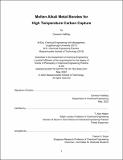Molten Alkali Metal Borates for High Temperature Carbon Capture
Author(s)
Halliday, Cameron
DownloadThesis PDF (35.29Mb)
Advisor
Hatton, T. Alan
Terms of use
Metadata
Show full item recordAbstract
The value generated by industrial processes including the production of power, chemicals, metals, and cement is undermined by the accumulation of CO2 in the atmosphere and resulting damage to the environment. Carbon Capture, Utilization, and Storage (CCUS) intercepts CO2 emissions, enabling the continued use of processes and resources that produce CO2 while minimizing their environmental impact. This thesis discovers, demonstrates, and designs systems for molten alkali metal borates, a novel class of material which are positioned to benefit from both liquid phase and high temperature operation. Material and chemical properties relating to CO2 capture were explored, the ability to capture multiple acid gasses simultaneously proposed, and steam investigated as a sweep gas for isothermal operation, demonstrating ~90% capture in bench scale experiments. As liquids with inherent immunity to morphological degradation the molten alkali metal borates displayed stable performance over 1,000 hours of continuous operation. However, harsh conditions introduced material compatibility challenges such as corrosive and chemical degradation. A nickel alloy was identified as a suitable material of construction and a path forward has been proposed to minimize degradation. Techno-economic evaluation of a conceptual coal fired power plant confirmed the predicted benefits. Levelized cost of electricity increased 39% (25% to 49%) relative to that for the power plant without carbon capture. The expected cost of CO2 avoided was $34/tonne ($18-56/tonne), 38% (27-50%) lower than that for the state-of-the-art amine process and competitive with the social cost of carbon. Bioenergy with Carbon Capture and Storage (BECCS) offered a unique opportunity to realize net-negative emissions while also producing reliable base-load electricity. BECCS could remove 300-850 kilograms of CO2 from the atmosphere per megawatt hour of electrical output (kgCO2/MWhe). The estimated cost of CO2 avoided was $45-50/tonne relative to coal, and $80-100/tonne relative to a largely renewable electrical grid. Other opportunities including Natural Gas Combined Cycle (NGCC) plants and Steam Methane Reforming (SMR) were found to be viable but less optimal. Although BECCS is not the only viable option it is seen as the most promising application with early adopters able to utilize low-cost resources and play an outsized role in climate change mitigation through net- negative emissions. The business case for BECCS identifies the need for net negative emissions credits with a nominal value greater than $100/tonne of CO2 to be considered further. Multiple sites exist with the upstream and downstream infrastructure necessary to support a first-of-a-kind plant, but new pellet plants and expanded CO2 pipelines could unlock other locations with lower costs.
Date issued
2022-05Department
Massachusetts Institute of Technology. Department of Chemical EngineeringPublisher
Massachusetts Institute of Technology